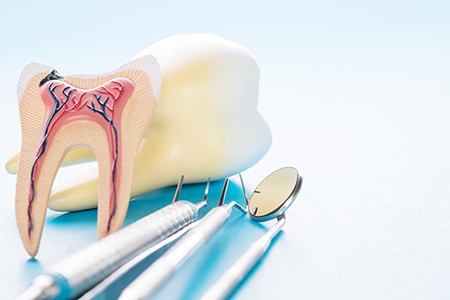If a dentist recommends root canal therapy, it’s not a cause for alarm — it’s a path to relief and to saving a tooth that is otherwise at risk. Modern root canal treatment focuses on removing infected or damaged tissue from inside the tooth, relieving pain, and restoring function so you can eat, speak, and smile comfortably again.
At the office of Edward J. Sharkey, DMD, we combine gentle care with up-to-date techniques to make the experience as predictable and comfortable as possible. Our priority is preserving your natural teeth whenever feasible while guiding you through each step of treatment with clear explanations and thoughtful post-treatment planning.
Saving a natural tooth usually offers the best long-term outcome for oral health. Even a well-made replacement cannot fully duplicate the feel and function of the original tooth and its root system. Root canal therapy maintains the tooth’s structure and helps prevent the surrounding bone and adjacent teeth from shifting or deteriorating.
In many cases, root canals are reliable and long-lasting. The procedure eliminates disease from the interior of the tooth and seals it against recontamination, enabling the tooth to remain in service for many years with proper restoration and maintenance. Choosing to preserve a tooth when appropriate supports chewing efficiency and reduces the need for more extensive future treatments.
Deciding between extraction and root canal treatment depends on several factors — how much healthy tooth remains, the tooth’s position and role in your bite, and the condition of the surrounding bone. Your dentist will assess these elements and recommend a course that prioritizes function, durability, and your overall oral health.

Teeth are more than enamel and dentin; at their core sits the dental pulp — a soft bundle of connective tissue, nerves, and blood vessels. That tissue helps teeth develop and can signal pain when something goes wrong. When decay, trauma, or repeated dental work breaches the protective layers, bacteria can reach the pulp and cause inflammation or infection.
Symptoms vary. Some people experience clear, persistent pain that worsens with chewing or at night, while others notice lingering sensitivity to hot or cold. In other cases, the infected tooth may darken, or the gum near the tooth may swell. Occasionally, a problem is discovered on a routine X-ray before symptoms appear.
Not every ache signals the need for a root canal, but when the pulp is irreversibly damaged or dead, treatment is needed to remove the infection and prevent it from spreading. Early evaluation helps preserve more of the natural tooth and often simplifies the restorative work that follows.
If you notice any of the following signs, schedule an evaluation so the cause can be identified and treated promptly:
Persistent pain that doesn’t resolve with time or that wakes you at night can indicate nerve involvement or a developing infection and should be evaluated without delay.
If hot or cold triggers a sharp response that continues after the stimulus is removed, the pulp may be inflamed or compromised.
Pain from pressure often points to damage within the tooth or to the surrounding tissues and can be a sign of pulp distress.
When a tooth changes color after trauma or over time, it can mean the internal tissues have been affected and require assessment.
Structural damage may expose the pulp or create pathways for bacteria; stabilizing and treating the tooth promptly can often prevent further complications.
Localized swelling or drainage from the gum signals that an infection is present and that care is needed to control it and relieve discomfort.
Advanced infection can affect the supporting bone and tissues, which sometimes causes mobility; addressing the source of infection can promote healing.
When a tooth’s pulp becomes infected, the condition rarely improves on its own. Timely treatment reduces the likelihood of more extensive damage to the tooth and the supporting bone, and it lowers the chance that the infection will spread to neighboring teeth or soft tissues.
Some teeth show clear symptoms, while others reveal problems only on radiographs taken during routine exams. That’s why regular dental checkups are valuable: radiographic or clinical clues can identify issues before pain or swelling develops, allowing for simpler and more predictable care.
Delaying care can result in increasing pain, a larger area of infection, and more complex restorative needs later. Early intervention helps preserve tooth structure and often reduces the number of visits required to complete treatment and restore chewing function.
Root canal therapy is designed to remove diseased tissue from the interior of the tooth, disinfect the canals, and seal them to prevent reinfection. The procedure is performed under local anesthesia so that most patients experience little or no discomfort during treatment.
Treatments vary by tooth complexity. Some teeth are straightforward and can be completed in a single visit; others have multiple canals or curved anatomy that require additional time or appointments. In cases of active infection, an initial visit may focus on controlling symptoms, with definitive cleaning and filling performed at a follow-up.
Modern instruments and techniques — from flexible rotary files to magnification and digital imaging — improve efficiency and the quality of canal shaping and cleaning. Sedation dentistry options are available for patients with dental anxiety, and your dentist will review these choices with you if they are appropriate.

After treatment, it’s common to feel some tenderness or mild soreness for a few days as the tissues around the tooth recover. Over-the-counter pain relievers usually control this discomfort, and it should diminish steadily. Your dentist will provide specific aftercare instructions based on the procedure performed.
A tooth that has undergone root canal therapy often requires a final restoration, such as a crown, to restore strength and protect against fracture. Leaving a tooth only temporarily restored can leave it vulnerable; completing the permanent restoration in a timely fashion helps ensure longevity.
Long-term success depends on good oral hygiene, routine dental visits, and prompt attention to any new symptoms. With appropriate restoration and regular care, a treated tooth can remain functional for many years, often for the life of the patient.

To support a smooth recovery and durable results, keep the following practical tips in mind:
Avoid chewing until sensation returns to reduce the risk of biting your lip or cheek while numb.
Mild soreness is normal after treatment. Follow your dentist’s guidance on pain relief and activity, and report any increasing or prolonged pain.
If antibiotics are recommended to address an infection, take the full course as directed to support complete healing.
Until a permanent crown or restoration is placed, avoid hard or sticky foods on that side to reduce stress on the tooth.
Continue brushing and flossing gently around the treated area; good hygiene helps protect the restored tooth and surrounding tissues.
Replacing a temporary filling with a properly fitted crown or permanent filling restores strength and prevents future complications.
At the office of Edward J. Sharkey, DMD, our team is committed to delivering careful, evidence-based root canal care and clear guidance for recovery and restoration. If you have concerns after treatment, or if new symptoms develop, contact us so we can evaluate and address them promptly.
In summary, root canal therapy is a reliable way to relieve pain, remove infection, and preserve natural teeth. If you think you may need evaluation or would like to learn more about how we approach endodontic care, please contact us for more information.
A root canal procedure is the best way to save a tooth that has been damaged by decay or injury and preserve your natural smile. The alternative is an extraction and treatment to replace the tooth. While at times a tooth is non-restorable and an extraction is the only option, when possible, it’s best to try and save your natural tooth. With proper care, a tooth with root canal therapy can serve your smile well for many years to come.
Despite lingering myths from before the age of modern dental anesthesia and technology, having a root canal procedure today is as routine and comfortable as visiting the dentist for a filling. While the procedure is performed under local anesthesia with your tooth completely numbed, we can also discuss options in dental sedation.
Whether the symptoms of a dental infection subside after a course of antibiotics, a draining abscess provides you with some temporary pain relief, or a tooth with radiographic evidence of pathology has not yet developed symptoms, it’s essential, before an infection worsens or occurs, to have a root canal procedure performed. In this way, the tooth can be disinfected, filled, and sealed to protect your health and avoid further problems.
If you have sustained a dental injury, have a toothache, jaw pain, swelling, or are experiencing any other unusual and uncomfortable oral symptoms, contact our office immediately for care. Dental problems that have not been evaluated and treated can significantly worsen, producing more severe damage and consequences for the involved teeth, your oral health, and even your overall wellbeing. Once you get in touch with our office, our friendly and compassionate office team will get you in for care at your earliest convenience.
While some root canal procedures can be completed in one visit, others may involve 2 or 3 appointments. How long it takes depends on various factors, including active infection, the number of canals in the tooth, and the tooth’s location or anatomy.
With a success rate that exceeds 95%, root canal therapy remains the most effective procedure to save a tooth in which the inner vital tissues have been damaged. However, as with all healthcare procedures, there are a small percentage of cases where the teeth become symptomatic a second time. The good news is that many of these teeth can still be saved with root canal retreatment or a minor surgical procedure known as an apicoectomy.
The best ways to maintain a tooth with root canal therapy are to get the proper restoration required to rebuild and protect the tooth, maintain proper oral hygiene, and schedule appointments for routine dental checkups and care.
Saving a tooth with root canal therapy is a wise investment that, in the long run, is typically less costly and invasive than having the tooth extracted and replaced with a fixed bridge or implant. As far as the exact cost of care, it can vary depending on which tooth is being treated. Many dental insurance plans provide coverage for root canal therapy. At the office of Edward J. Sharkey, DMD, we do our best to optimize your dental benefits and minimize your out-of-pocket expenses. Our staff will answer all your questions about the cost of care and discuss all your payment options.
At the office of Edward J. Sharkey, DMD, we use the latest technology and most effective methods of care to provide precise and gentle care. Our reputation for excellence is based upon a consistent record of achieving successful treatment outcomes while providing prompt, stress-free, and convenient treatment for every type of dental need.